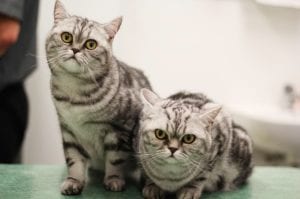Medicine may come in the following formulations:-
- Tablets.
- Capsules – powder contained within a dissolvable gelatin container.
- Powder.
- Syrups.
- Injections (insulin only).
- Enemas/suppositories.
- Your vet will advise you whether it is important that the medication is given with food or on an empty stomach.
- Always complete any course of treatment that is prescribed and follow the instructions that you are given with respect to the dose and timing of medication.
- If you are concerned about your cats response to treatment or if any new signs develop then consult your veterinary surgeon as soon as possible. In particular if the cat’s appetite diminishes or vomiting occurs, consult the vet.
- Do not alter or stop therapy without consulting your veterinary surgeon since this may result in complications.
It is important that your cat receives the prescribed medication and this may be achieved by one of the following:
- The medicine can be mixed with your cats food as long as it is not necessary to give the medicine on an empty stomach. This technique may be unsuccessful if it results in your cat being put off eating its food or if you have any other animals that may eat it. This method is most useful for dosing powders and syrups. Most tablets can be crushed and mixed with food, however some tablets are not designed to be crushed so check with your vet before doing this. This is the least reliable way to medicate your cat.
- Small tablets may be hidden in a piece of your cats favourite food and offered as a treat. Cheese, butter and pieces of meat are common favourites.
- In diabetic cats insulin therapy may be needed. This usually involves daily subcutaneous injections of insulin and is a procedure that you will be trained to do if necessary.
- If enemas are prescribed, your vet will teach you how to administer these.
- Oral dosing may be the only technique by which you are able to guarantee successful medication. This usually requires two people with one person holding the cat while the other person administers the treatment. This is the most reliable way to medicate your cat.
If you are having problems then get back to your vet as a matter of urgency as it is very important that medication is continued and given regularly.
- The holder should stand behind the cat and place the palms of their hands on either side of the cats chest, cupping their fingers around the front of this. Since cats will often reach up with their paws when dosed, it is usually necessary to hold the front legs as well. The front legs may be held between the third and fourth fingers whilst still steadying the cat’s chest. The holders arms and upper body can be used to enclose the cat so that it is securely immobilised!
- The doser stands to the side or in front of the cat and places their thumb and third finger of one hand over the angles of the jaw (just below the ears on both sides ). The palm of this hand is rested over the top of the cats head. The tablet is held between the thumb and second fingers of the other hand and the forefinger is placed on the lower jaw over the front incisors. The mouth can then be opened and the tablet dropped at the back of this. It is important that the tablet is placed at the back of the cats mouth since otherwise the cat will be able to spit this out.
Specially designed pill and capsule administration devices are available and your vet may be able to supply you with one of these. These allow the pill to be put at the back of the cats mouth without the risk of being bitten!
This procedure is also best done with two people and the cat may be gently restrained as described above. The doser administers the liquid by a syringe which is gently inserted in the side of the cats mouth with the nozzle placed between the upper and lower teeth. Any liquids should be given slowly to allow time for swallowing. If your cat becomes distressed while this is being done then it is probably not the best way to dose it since the liquid may be inhaled which can cause pneumonia.

